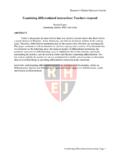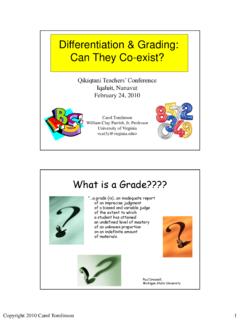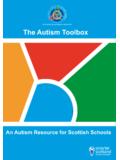Transcription of A curriculum for all learners - UCL Institute of …
1 A curriculum for all learners Guidance to support teachers of learners with additional learning needs Cymry Ifanc Young Wa les A curriculum for all learners Guidance to support teachers of learners with additional learning needs Audience All maintained primary, secondary and special schools in Wales;. institutions for teacher education and training; local authorities;. teacher unions and school representative bodies; church diocesan authorities; national bodies in Wales and others with an interest in education. Overview These materials provide guidance for teachers of learners with a range of additional learning needs (see Appendix 1) in mainstream and special settings/schools in teaching and assessing against the school curriculum 2008. While the guidance is primarily focused on Key Stages 2 and 3, it will be useful to staff working in the Foundation Phase and with learners aged 14 19 in a variety of settings. Action This guidance may be used by individual practitioners, teachers and required staff teams in schools, by those with curriculum and/or assessment responsibilities, SENCOs and senior managers and by local authorities (LAs) to support groups of schools in reviewing their curriculum and assessment practice.
2 Further Enquiries about this document should be directed to: information curriculum and Assessment Division Department for Children, Education, Lifelong Learning and Skills Welsh Assembly Government Cathays Park Cardiff CF10 3NQ. Tel: 0800 083 6003. e-mail: Additional Can be obtained from: copies Tel: 0845 603 1108 (English medium). 0870 242 3206 (Welsh medium). Fax: 01767 375 920. e-mail: Or by visiting the Welsh Assembly Government's website Ref: AC/GM/0862 A-EAC-02-01-A756973/1/ND. ISBN: 978 0 7504 4708 9 Crown copyright March 2010. Contents Introduction 3. Section 1: Planning to include all learners 5. Planning a relevant curriculum 6. From differentiation to transforming learning capacity 13. Meeting the needs of more able and talented learners 16. Using the skills framework 18. The personal and social education framework 18. Foundation Phase 19. curriculum and assessment 8 14 20. 14 19 Learning Pathways 20. Transition 23. curriculum FAQs your questions answered 24.
3 curriculum monitoring and evaluation 30. Section 2: Assessing all learners 33. The revised assessment framework 34. Using the national curriculum outcomes 35. The relationship between formative and summative 37. assessment Monitoring learners progress 40. Expectations of learner progress 41. Foundation Phase Child Development Profile 44. Year 5 skills assessment 44. Wider measures of progress 45. Use of Routes for Learning for summative, end of key 48. stage assessment for learners with complex needs Support for teacher assessment 51. Assessment for Learning 53. Including all learners final thoughts 55. Section 3: Appendices 57. Appendix 1: Defining additional learning needs 58. Appendix 2: Developing an inclusive curriculum questions to 61. support schools in meeting additional learning needs Appendix 3: Inclusive teaching strategies 63. Appendix 4: curriculum models for learners with complex 65. needs Appendix 5: Reviewing assessment practice 68.
4 Appendix 6: Using assessment evidence 72. Appendix 7: References, further reading and useful websites 74. Acknowledgements 77. Introduction The Welsh Assembly Government set out its vision for children and young people in Children and Young People: Rights to Action (2005). This vision is based on the United Nations (UN) Convention on the Rights of the Child and has seven core aims which seek to ensure that all children and young people: s have a flying start in life s have a comprehensive range of education and learning opportunities s enjoy the best possible health and are free from abuse, victimisation and exploitation s have access to play, leisure, sporting and cultural activities s are listened to, treated with respect, and have their race and cultural identity recognised s have a safe home and a community which supports physical and emotional well-being s are not disadvantaged by poverty. Inclusion is everyone's responsibility. It is not only about where learners receive their education but about the provision of a meaningful education which will foster independence and inclusion in society as a whole.
5 To support this vision and ensure that all learners have an education which develops their potential to the full, the Including all learners '. statement in the curriculum subject Orders (2008) and linked frameworks summarises the requirements on schools under the equal opportunities legislation. This includes the Sex Discrimination Act 1975, Disability Discrimination Act 1995, Race Relations Act 1996, Human Rights Act 1998, Special Educational Needs and Disability Act 2001 and the Equalities Act 2006. Further information on the Statutory Framework can be found in Inclusion and Pupil Support (NAfW Circular 47/2006). A definition of additional learning needs can be found in Appendix 1 (page 58). A curriculum for all learners 3. 4 A curriculum for all learners 1. Section Planning to include all learners A curriculum for all learners 5. Planning a relevant curriculum The Including all learners ' statement should be used by settings/schools to look at their existing arrangements and identify good practice, while also drawing attention to any ways of working which might create environmental or social barriers to participation and engagement.
6 Settings/schools must work to provide an inclusive curriculum which offers opportunities for all learners to achieve and contribute to today's multi-ethnic Wales. To enable all learners to access relevant skills, knowledge and understanding at an appropriate level, schools may select content from the Foundation Phase or any key stage within the curriculum and use it flexibly, together with the Skills framework for 3 to 19-year-olds in Wales (Welsh Assembly Government, 2008), in order to: s provide a meaningful relevant and motivating curriculum for their learners s meet the specific needs of their learners and further their all round development. In addition to the national curriculum subject Orders, the linked frameworks for personal and social education (PSE) (2008) and for developing thinking, communication, number and information and communication technology (ICT) may be given greater emphasis across the curriculum to meet each learner's individual needs.
7 Figure 1 shows that, for effective learning to take place, the physical, safety, social and self-esteem needs outlined in the lower tier of the diagram must first be met. The second tier shows content which will form the basis of a relevant curriculum for all learners developing thinking, communication, personal and social skills. This may also include physical, orientation and mobility skills, life skills and leisure and recreational skills. For learners with more complex needs, subject skills, knowledge and understanding may not be high priority but content can be selected from Areas of Learning/subject programmes of study which is relevant to learner needs and which will additionally provide interesting contexts for continuing work on individual priorities. For some learners , physiotherapy, speech therapy, occupational therapy and other additional areas may be an integral part of the curriculum . 6 A curriculum for all learners Overall, the curriculum for every learner should aim to provide real understanding and relevant life skills not just coverage' of subject content.
8 An effective curriculum is not a series of one off' learning experiences. It must be planned with the needs of the learner in mind to ensure that individual priorities and key concepts are revisited in different contexts to ensure learning, transfer and embedding of relevant skills and understanding. Schools must provide a broad, balanced curriculum which includes the national curriculum and religious education (RE) and they should provide a clear explanation for the decisions made regarding curricular emphases in the light of the learners ' needs and the requirements of the equalities legislation. The resulting rationale should be documented in whole curriculum or subject policy statements. The questions in Appendix 2 may be used to support this process. Fig. 1: Planning an inclusive curriculum g Increasing emphasis on subject Subject specific skills, knowledge and skills, knowldge, understanding understanding planned from FP Areas of (depth).
9 Learning, NC subjects, 14 19 pathways Reinforcement of key skills . increasing independence. Developing thinking, communication, number, ICT, PSE across the curriculum Increasing emphasis on key skills, learning to learn, using relevant subject PoS in outline Physical safety, social, self-esteem (extended/adapted) to provide needs, need for fulfilment, recognition, breadth/age appropriate respect, emotional growth contexts for learners ' priorities. A curriculum for all learners 7. s Long term plans: should give an overview of the content selected from Areas of Learning or subject programmes of study together with skills from the developing thinking, communication, number and ICT frameworks. The plans should use the age appropriate programmes of study as a starting point, drawing on relevant content and/or contexts for learning if some content is not accessible to all learners . In such cases, teachers should look at the earlier Areas of Learning/.
10 Programmes of study as a basis for outlining the key concepts, essential questions and life skills which learners will need to become independent learners . Schools may identify these concepts within Areas of Learning/subjects to be taught in blocked units or continuing units and show links between subject areas and skills to ensure coherence. Plans should also show progression and continuity across key stages in broad terms to clarify learners ' entitlement to breadth and balance within the curriculum . Four year rolling programme Key Stage 2 (resourced provision for learners with severe learning difficulties). The approach to planning shown in Figure 2 ensures progression, continuity and coverage without repetition for Key Stage 2 classes. Common themes have been used in some cases to group subjects together, avoid fragmentation and promote the generalisation of skills. The school emphasises the process of learning and avoids superficial content coverage.

















